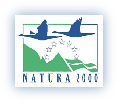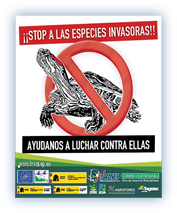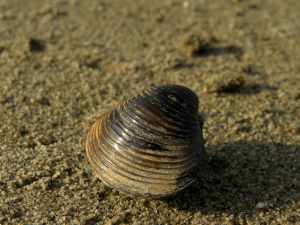

LIFE 10 NAT/ES/000582
Lucha contra las especies invasoras en las cuencas hidrográficas de los ríos Tajo y Guadiana en la Península Ibérica






Beneficiario Coordinador
Cofinanciador
Beneficiario Asociados


Colaboradores
© 2017 Consejería de Medio Ambiente y Rural, Políticas
Agrarias y Territorio - DG Medio Ambiente - GPEX
Con la contribución del instrumento financiero LIFE de la Unión Europea
Agrarias y Territorio - DG Medio Ambiente - GPEX
Con la contribución del instrumento financiero LIFE de la Unión Europea
Other languages

Autoecology
ain habitat: it grows in soils containing silt or clay, in gravel beds, or clear water rivers.
Features of native and invaded ecosystems: it invades both confined and open water settings. This species does not fix to hard substratrum environments.
Breeding: generally speaking, this is an hermaphrodite species, although some dioecious individuals may occur in our country. It reproduces in a sexual way, and incubation takes place inside the gills. After 4-5 days of incubation, larvae are shed into the substratum where they will complete their development. Juveniles get fixed to the substratum through the mucilagenous byssus thread, and they are completely mature in 3-6 months. Generally, this species has two reproductive cycles per year, one between spring and summer, and the other one at the end of summer or at the beginning of autumn. It might have only one reproductive cycle depending on water conditions and feeding resources.
Asian Clam (Corbicula fluminea)
Species description
Hermaphrodite or dioecious bivalve mollusc of oval shape, native to the Far East (Southeastern Chine, Korea, and Southeastern Russia).
Valves are hard, of brown, greenish, and yellowish tones; and they have concentric rings. The periostracum is golden green; and the shells are lightly purple on the inside. It might be up to 5 cm long, and live for 7 years. It is not sexually dimorphic.
It is not a very active species, which essentially half-buries itself in the substrate, and filters water in order to get nourishment from organic particles such as seaweed, microplankton, etc.
Species description
Hermaphrodite or dioecious bivalve mollusc of oval shape, native to the Far East (Southeastern Chine, Korea, and Southeastern Russia).
Valves are hard, of brown, greenish, and yellowish tones; and they have concentric rings. The periostracum is golden green; and the shells are lightly purple on the inside. It might be up to 5 cm long, and live for 7 years. It is not sexually dimorphic.
It is not a very active species, which essentially half-buries itself in the substrate, and filters water in order to get nourishment from organic particles such as seaweed, microplankton, etc.
Pathways of Introduction and Expansion
Its introduction took place in an accidental way, it being caused by human activity (ballast water of transoceanic vessels, gastronomic purposes, etc.). The first reference to this species in Spain dates from 1981. It was cited in the Miño river in 1989; in Catalonia in 1990; and in the Guadiana drainage basin (Extremadura) in 2005. Nowadays, it can be found in almost every drainage basin in Spain.
Current use in Spain and the Duero Basin: it is used as bait in sport fishing.
Main dispersal vectors: it spreads through planktonic and juvenile larvae in suspension in running water, ballast water, when used as bait, etc.
Its introduction took place in an accidental way, it being caused by human activity (ballast water of transoceanic vessels, gastronomic purposes, etc.). The first reference to this species in Spain dates from 1981. It was cited in the Miño river in 1989; in Catalonia in 1990; and in the Guadiana drainage basin (Extremadura) in 2005. Nowadays, it can be found in almost every drainage basin in Spain.
Current use in Spain and the Duero Basin: it is used as bait in sport fishing.
Main dispersal vectors: it spreads through planktonic and juvenile larvae in suspension in running water, ballast water, when used as bait, etc.
Impact
Ecological: its high grow rate, high reproductive potential, its early sexual maturity, as well as its dispersal capacity through human activities make of this species a very harmful invader. It compites with native freshwater bivalves for space and food, and it might alter phytoplankton levels in ecosystems.
Economical: this species may obstruct irrigation systems, intake pipes, etc. in industrial infrastructures … which leads to important economical losses.
Public Health: the seasonal mortality of this species due to draught, etc. contributes to the contamination of water supplies.
Affected processes, communities or species: it competes with native bivalves, and it also alters flora and faura diversity and quantity.
Ecological: its high grow rate, high reproductive potential, its early sexual maturity, as well as its dispersal capacity through human activities make of this species a very harmful invader. It compites with native freshwater bivalves for space and food, and it might alter phytoplankton levels in ecosystems.
Economical: this species may obstruct irrigation systems, intake pipes, etc. in industrial infrastructures … which leads to important economical losses.
Public Health: the seasonal mortality of this species due to draught, etc. contributes to the contamination of water supplies.
Affected processes, communities or species: it competes with native bivalves, and it also alters flora and faura diversity and quantity.


Almeja asiática - © Naturgucker

























